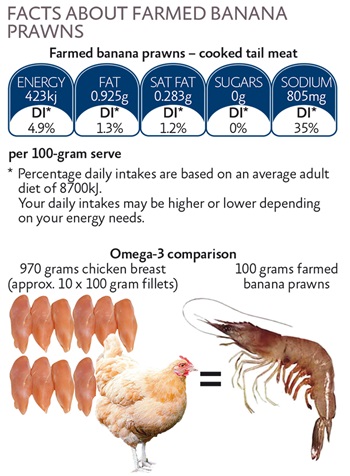To help consumers better understand the health benefits of seafood, some of Australia’s most popular species have undergone nutritional evaluation
 Super Seafood is the Australian Seafood Cooperative Research Centre’s new guide that details the nutritional analysis of our 20 most popular seafood species.
Super Seafood is the Australian Seafood Cooperative Research Centre’s new guide that details the nutritional analysis of our 20 most popular seafood species.By Lynda Delacey
The release of the most comprehensive study of Australian seafood nutrition to be undertaken in more than a decade will provide the foundation for improved advice to consumers about the health benefits of seafood and help prepare the industry for new market requirements.
The study focuses on the top 20 seafood species Australians consume, including Atlantic Salmon, Barramundi, prawns, oysters and rocklobster.
It has been co-funded by the Australian Seafood Cooperative Research Centre (Seafood CRC) and the FRDC, and was undertaken by David Padula at the South Australian Research and Development Institute (SARDI) based in Adelaide.

Seafood CRC managing director Len Stephens says there were four drivers for the study.
“Firstly, consumers are increasingly interested in what’s in the food they eat and the previous study was conducted more than 10 years ago. So we wanted to provide updated data using the most accurate methodologies available,” he says.
“Secondly, new species such as Yellowtail Kingfish are becoming very popular, so we wanted to ensure we had robust information about them.
“Thirdly, new labelling legislation is coming so we wanted to ensure seafood processors had up-to-date information in readiness. And lastly, our export customers in China tend to be very keen to know the nutrient content of our seafood exports, so we needed to support that.”
Project leader at SARDI Cath McLeod says the research generated a massive amount of important data on wild and farmed Australian seafood.
“Using advanced testing methods, including DNA profiling to confirm each fish species, we looked at the energy, protein, fat, sodium, fatty acids, water, vitamins and minerals in a variety of Australia’s key seafood species, including farmed Yellowtail Kingfish, wild Banana Prawns and Native Oysters.”
The study also focused on lead and cadmium levels, and all species tested met Australian regulatory standards.
The results are good news for Australian seafood lovers and the seafood industry, reinforcing the value of Australia’s clean seas.
“This should provide peace of mind for Australian consumers and ease market access issues for industry,” Len Stephens says. “The results are a testament to the high quality of management of the Australian fisheries and aquaculture industries.”
Seafood CRC program manager Emily Mantilla says the results show that seafood and fish compare well nutritionally with chicken and beef.
“All of the species tested contained higher levels of health-promoting omega-3 fatty acids. Several species, including Atlantic Salmon and Sardines, were found to contain particularly high quantities of important vitamins and minerals and omega-3 fatty acids.”
Nutrition and dietetics experts from Flinders University in SA and the Centre of Excellence for Science, Seafood and Health at Curtin University in Western Australia evaluated the data for ‘source’ and ‘good source’ health claims for important vitamins, minerals and omega-3 fatty acids to develop key nutrient messages relevant to the consumer.
Food Standards Australia New Zealand has incorporated the data into its food composition reference database, which is used as an information source for nutrition information panels published on food items.
The findings from the study are being developed into a wide range of resources for industry, including nutrition information panels, dietary intake guides and other info-graphic images available for use in packaging and marketing materials and labels.
A handbook, Super Seafood, based on the report has been released to retailers to help Australian consumers understand the nutritional value of different fish and seafood. The Super Seafood kit is available from the Seafood CRC website.





